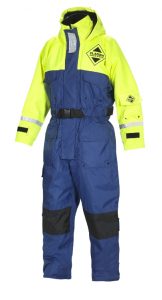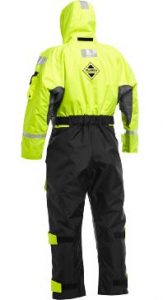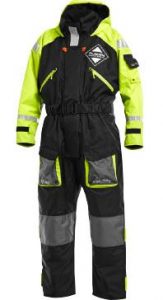This is my latest article for Boats and Outboards on the subject of Communication at Sea. An essential read for anyone who ventures to sea. Do get in touch if you need help with your communication equipment requirements.
https://www.boatsandoutboards.co.uk/advice/communication-at-sea/161
Category Archives: Blog
A list of blogs and posts from OneOcean’s shoreside and yachting activities.
Cold Water Shock – an essential read
This is my latest article for Boats and Outboards on the subject of Cold Water Shock. Though it refers to the colder months it actually applies to UK waters for the whole year. This is an essential read for anyone who goes to sea.
Cold Water Shock – A Survival Guide – Meuryn Hughes – January 2019
When is a lifejacket not a lifejacket?
My recent client will not mind me posting these photographs, nor writing about this subject. The client, a novice sailor was keen to learn and so decided to buy his own lifejacket for a course with OneOcean and on arrival presented the jacket to me for inspection prior to fitting.
It looked like a lifejacket and on the front in big bold writing was the word LIFEJACKET. It was red in colour with black straps. No crotch straps.
On closer inspection I saw that there was no CE mark nor ISO on the lifejacket – neither on the outside nor inside.
When I opened the lifejacket I was stunned with what I read – or more importantly what I could not read. All the text was in Chinese.
There was no way I could check to see if this lifejacket complied with any certification.
Without the ISO mark nor the CE mark or the SOLAS wheel there was no way the wearer could guarantee that the lifejacket has passed the rigorous testing that is required to be awarded these certifications.
This was not a lifejacket, but a deathjacket.
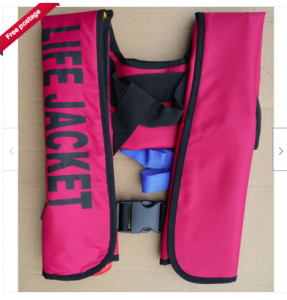
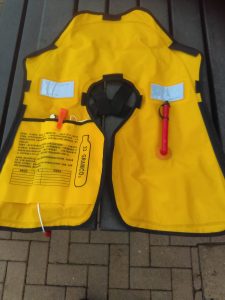
In the event of an emergency, a Man Over Board situation or if the wearer entered the water there is a possibility this jacket would not deploy. It may deploy but the fabric may not be strong enough to take the pressure of the CO2 cylinder – IF the cylinder has any CO2 in it, and if the deployment mechanism works.
Entering the water in any condition is a fearful situation, and in an emergency it is imperative that you have the correct equipment to assist you with your survival. Otherwise, the chances of survival are drastically reduced.
These factors are not worth even thinking about when going to sea. So the message is clear : do not buy cheap lifejackets.
The client was horrified and said he would buy a new lifejacket immediately. I advised him that a lifejacket would cost him in the range of £60-£130 depending on what he required, but he needed to ensure that the ISO, CE Mark or SOLAS wheel was marked clearly on the lifejacket.
He bought this lifejacket for less than £20.
My advice is always : spend as much as you can on life saving equipment as one day your life will depend on it.
Read Meuryn Hughes’ 2012 article in Powerboat and RHIB magazine about Lifejackets :
Lifejacketsordeathjackets – Meuryn Hughes Article
Since July 1995, it has been illegal to sell Lifejackets or Buoyancy Aids that have not been tested to European or International specifications.
There are several classifications for ISO Approval.
CE standards deal with various categories of buoyancy performance, the big four are shown below. The rating is for an adult size so smaller sizes have proportionally less buoyancy:
ISO12402-5, covers 50N buoyancy aids, providing a minimum of 5kg of buoyancy.
ISO12402-4, covers 100N lifejackets, providing a minimum of 10kg of buoyancy.
ISO12402-3, covers 150N lifejackets, providing a minimum of 15kg of buoyancy.
ISO12402-2, covers 275N lifejackets, providing a minimum of 27.5kg of buoyancy.
Buoyancy explained
Newtons, are a measure of force. 10 Newtons (or 10N in lifejacket speak) is equivalent to 1 kilogram of buoyancy. So a 150 Newton lifejacket (or 150N) provides 15kg of buoyancy. Remember these are the minimum buoyancy requirements for the European standard, so the actual vest or lifejacket may provide more.
Children’s life jackets are commonly rated as 100N or 150N but they don’t actually have that much buoyancy. For example a kids foam lifejacket size 10-20kg has 30N of buoyancy.
What else does ISO approval cover?
ISO approval also covers other features not just buoyancy ratings. These include the design, performance, specification of materials used in manufacture, and even the information that the user guide provides.
Further reading:
Lifejacket Maintenance Leaflet
HM Coastguard adopts RYA SafeTrx as new Safety ID Scheme
RYA SafeTrx now supersedes the HM Coastguard CG66 scheme
The Maritime & Coastguard Agency (MCA) and the Royal Yachting Association (RYA) have today joined forces to reveal RYA SafeTrx as HM Coastguard’s new official voluntary safety identification scheme.
RYA SafeTrx: designed to improve safety at sea
The world-leading RYA SafeTrx app is designed to improve safety at sea and potentially cut vital minutes off the time taken to pinpoint a casualty’s location. It monitors your boat journeys and alerts designated emergency contacts should you fail to arrive on time.
Using iPhone and Android smartphone technology, this free tracking and alerting system is easily accessible and ideal for everyone who enjoys being on the water – from kitesurfers and kayakers to dinghy sailors and powerboat users.
Notify the Coastguard at the touch of a button

The free RYA SafeTrx mobile app and website now supersedes the HM Coastguard CG66 scheme. It combines a more technologically cutting-edge version of the CG66 database function with additional lifesaving technologies so that you can make a 999 call to the Coastguard at the touch of a button.
The app can be used free of charge in UK territorial waters. Maritime search and rescue agencies in Ireland, the Netherlands, Germany, Spain, Finland, Norway, Cyprus, South Africa and Australia have already adopted the app.
Freely available to any UK resident
The RYA SafeTrx app is available to any UK resident who wants to be safer afloat and already has over 13,000 users. It provides all recreational boat users with an accessible and simple-to-use way of automatically informing HM Coastguard of their voyage plans, vessel and crew information, incident data, dynamic location and even a direct 999 connection in the event of distress.
“When we receive an emergency call we need a huge amount of information fast. This app helps us access all your details so that you can get a swifter response with the right resources,” says the MCA’s Director of Maritime Operations & HM Coastguard, Richard Parkes.
“RYA SafeTrx uses real-time advanced technology. CG66 was just a database, but the new app allows users to do so much more, including summoning the Coastguard – which could save lives. The precise geolocation feature, for example, allows the Coastguard to know where the caller is, an important consideration when the person in distress is unsure of where they are, disoriented, injured or unfamiliar with the area.
“We have already contacted CG66 users to tell them about the switchover to RYA SafeTrx. The handover is well underway and from Wednesday 11 July people will be redirected from GOV.UK’s CG66 page to the RYA SafeTrx website. Information on CG66 will still be accessible to the Coastguard, but we will no longer be accepting new information.
“I’d like to take this opportunity to remind all boaters that you must continue to use emergency alerting equipment appropriate to your sport. RYA SafeTrx complements this equipment, but is not designed to be used instead of it.”
Cold weather clothing
With OneOcean practical courses running twelve months of the year the question of appropriate clothing for students on our courses is one that arises all the time. Over the years we have advised our students to wear thermals, in several layers, with an outer layer covered with waterproofs.
This was fine until the Mecal the certifying authority for our charter sailing vessel Tiger 2, insisted that all charterers wore an immersion suit approved to ISO 15027:1 (Constant Wear Immersion Suit). We were left with a simple choice: either purchase enough immersion suits for every student, making sure we have enough different sizes to fit all, or not to run any sailing courses between 1st November and 1st March nor when the sea temperature was below 10ºC.
I decided to pull the February course and reschedule for late March when the sea temperature would be higher than the required 10ºC.
In the event, my students, all of them wonderful, stated that they wanted to buy the immersion suits for themselves and wanted the course to continue. I purchased my own and negotiated a small discount for each of my four students.
I have to say I AM impressed. The Fladen Rescue System One Piece is warm, comfortable, very easy to wear whilst working the deck, and after eight hours in the open and inclement elements not one of us were cold in any way. They are not breathable so there is a likelihood of sweat forming on the inner when working hard but essentially I have to say this kit puts all my labelled sailing clothing in second place as far as kit for cold weather, winter and inclement weather kit is concerned. I can see myself using this all year round and at a price of just under £100 anyone who sails in UK waters should include it as part of their kit.
OneOcean’s sister company OneOceanTec now sells Fladen products so take a look at the Fladen Rescue System One Piece at https://www.oneoceantec.co.uk/product-category/fladen/
Scope of the ICC
The United Nations Economic Commission for Europe Inland Transport Committee Resolution 40 (hereafter called Resolution 40) International Certificate for Operators of Pleasure Craft (known in the UK as the International Certificate of Competence (ICC)) is documentary assurance from one government to another that the holder meets the levels of competence laid down in Resolution 40. It is NOT a qualification.
The resolution states that the ICC may be issued by a government to its nationals and residents who are operators of pleasure craft in the waters of other signatory countries, on condition that it accepts the requirements and conditions set out in Resolution 40. This means that a UK ICC should allow UK Citizens and bonafide UK residents to navigate pleasure craft to or in the waters of foreign states that participate in Resolution 40, without the need to comply with those states’ laws, particularly their national certification requirements which in many cases are compulsory.
The UK is one of only a few countries which have fully accepted Resolution 40. Many countries have not adopted Resolution 40, some still apply Resolution 14 which Resolution 40 was intended to replace. Others only apply Resolution 40 in part or with caveats attached. In reality, however, the ICC is more widely accepted as proof of the holder’s competence. Spain, Greece and Portugal for example, have not adopted Resolution 40 but are still most likely to ask visitors for an ICC.
Some states may accept UK (RYA) ICC as an alternative to their national qualification on their nationally flagged vessels, but this should NEVER be assumed. The onus is on ICC holders to determine its acceptability by foreign states.
The ICC was never intended to be an alternative to individual national qualification requirements. The advice to anyone planning to charter abroad is to obtain from the charter company (preferably in writing) details of the certification they require, what cruising area this is acceptable for and that this certification will also meet the requirements of the relevant authorities in the area concerned.
The RYA through the European Boating Association, is working towards wider acceptance of Resolution 40 and conformity in its application. Once Resolution 40 is universally adopted, the ICC may then become more like an international driving licence in application for visitors.
